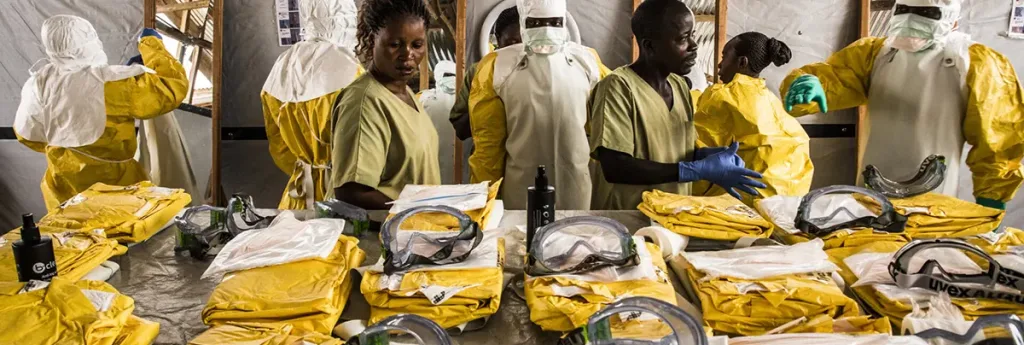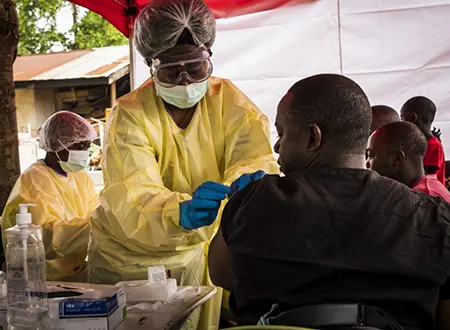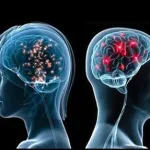Scientists Find Powerful Way to Stop Ebola: Top 1 Exciting News

Overview: What is Ebola?
Ebola, also known as Ebola virus disease (EVD) or Ebola hemorrhagic fever (EHF), is a rare yet severe illness affecting humans and other primates. It is caused by ebolaviruses, belonging to the virus family Filoviridae.
Scientists have achieved significant breakthroughs in understanding Ebola. One key discovery is the formation of inter-cellular tunnels by the virus. These tunnels allow Ebola to move stealthily from cell to cell, evading the host’s immune system. Additionally, the World Health Organization (WHO) has recommended two monoclonal antibody treatments—mAb114 (Ansuvimab; Ebanga) and REGN-EB3 (Inmazeb)—to improve survival rates among Ebola patients. These treatments represent a crucial advancement in combating the disease. Furthermore, recent studies have revealed that Ebola can persist in the brain even after treatment, shedding light on the virus’s ability to evade eradication and potentially leading to new strategies for long-term management.
What are the Latest discoveries about Ebola?
In a remarkable discovery, scientists have unlocked a masterful solution to combat the deadly Ebola virus. Their groundbreaking research illuminates a path toward unforgettable therapies that could revolutionize public health. Brace yourself for the thrilling revelation that promises to alter the course of viral medicine.

Through a fusion of experimental and computational wizardry, researchers pinpointed a critical interaction between the Ebola virus VP35 protein and a human protein called ubiquitin. This newfound vulnerability offers a captivating target for drug intervention. Advanced computational modeling predicted the binding interface, paving the way for practical drug design. Imagine disrupting the virus’s replication machinery—a genius move in the battle against Ebola.
Ebola, notorious for its devastating outbreaks, exacts a heavy toll on human lives. But now, armed with this knowledge, we can ignite hope. By slowing down viral replication, we inch closer to a world where Ebola’s grip loosens. The study, published in the prestigious journal PLOS Biology, unveils a blueprint for life-saving treatments. It’s not just about better—it’s about undeniable progress.
The intricate dance between Ebola and our immune system becomes clearer. The virus, bold and cunning, evades detection, subverting our defenses. But understanding its moves empowers us to fight back. This research underscores the profound importance of unraveling viral complexities. With each revelation, we inch closer to a healthier, more resilient world.
Prepare to be awestruck by this extraordinary leap forward—a beacon of hope in the face of adversity. The battle against Ebola just got a powerful ally: science.
How does this drug work?
The drug zeroes in on a specific protein within the Ebola virus called VP35. This protein plays a crucial role in the virus’s replication process. By disrupting VP35’s function, the drug aims to hinder the virus’s ability to multiply and spread within the host.
Scientists discovered that VP35 interacts with a human protein called ubiquitin. This interaction is essential for the virus’s survival. The drug exploits this vulnerability, preventing VP35 from carrying out its normal functions. Imagine it as a lock-and-key mechanism—the drug fits into VP35 like a puzzle piece, rendering it ineffective.
Viruses, including Ebola, rely on host cells to replicate. By blocking VP35, the drug slows down viral replication. This reduction in viral load gives the immune system a fighting chance to mount a defense and prevent the virus from overwhelming the body.
The drug’s discovery represents a beacon of hope. It’s not just about stopping Ebola—it’s about saving lives and preventing future outbreaks. As research continues, we may witness more breakthroughs, ultimately leading to effective treatments and, perhaps, a world where Ebola is no longer a deadly threat.
Remember, science’s relentless pursuit of knowledge empowers us to confront even the most formidable adversaries.
How long does it take to recover from Ebola?
After exposure, symptoms typically appear between 2 to 21 days. A person with Ebola can spread the disease once symptoms manifest. Even after recovery, the virus may linger in certain parts of the body, such as the eyes, central nervous system, and semen.
Recovery hinges on good supportive care and the patient’s immune response. Promising treatments are enhancing overall survival. Survivors develop antibodies that can last up to 10 years, possibly longer.
Weeks or months of body aches and weakness are common post-recovery. Ebola can persist in semen for at least three months after recovery. Safe practices are crucial during this period.
Remember, resilience and science walk hand in hand. Survivors carry the torch of hope, illuminating the path toward a healthier future.
What are the 5 symptoms of Ebola?
The primary signs and symptoms of Ebola virus disease (EVD) in more detail:
Primary Signs and Symptoms:
-
Fever: Ebola virus disease typically begins with a sudden onset of high body temperature. This fever is often one of the earliest indicators of infection.
-
Aches and Pains: Individuals with EVD commonly experience severe headaches, muscle aches, and joint pain. These symptoms can be debilitating and contribute to the overall discomfort associated with the illness.
-
Weakness and Fatigue: Profound weariness and exhaustion are hallmark symptoms of Ebola. Patients often report feeling extremely weak and fatigued, making it difficult to carry out daily activities.
-
Sore Throat: Many individuals with EVD experience discomfort and irritation in the throat, often characterized by a sore throat. This symptom can contribute to difficulty swallowing and general discomfort.
-
Loss of Appetite: Food loses its allure for individuals infected with Ebola. Loss of appetite is common and can lead to significant weight loss and nutritional deficiencies if not addressed.
Progressive Symptoms:
As the illness progresses, additional symptoms may emerge, including:
-
Gastrointestinal Symptoms: Patients may experience abdominal pain, diarrhea, and vomiting. These gastrointestinal symptoms can contribute to dehydration and electrolyte imbalances.
-
Unexplained Hemorrhaging: In severe cases of EVD, individuals may experience unexplained bleeding or bruising without an apparent cause. This symptom is a hallmark feature of Ebola hemorrhagic fever.
-
Other Notable Symptoms: Some patients may develop red eyes, a skin rash, or persistent hiccups as the illness progresses. These symptoms can vary in severity and may not be present in all cases.
It’s important to note that while these symptoms are characteristic of Ebola virus disease, they can also overlap with those of other common illnesses, such as influenza (flu), malaria, or typhoid fever. If you suspect Ebola or encounter these symptoms, seeking medical attention promptly is crucial. Science and vigilance are our allies in the battle against this invisible adversary.
What is the way to prevent Ebola?
The preventive measures and the vaccine available for protection against the disease caused by the Ebola virus:
Prevention Methods:
When living in or traveling to regions where the disease is potentially present, it’s crucial to follow these preventive measures:
-
Avoiding Contact with Infected Individuals:
- Steer clear of direct contact with blood and bodily fluids (such as urine, feces, saliva, sweat, vomit, breast milk, amniotic fluid, semen, and vaginal fluids) of individuals who are sick.
- Refrain from contact with bodily fluids from a person who has recovered from the disease until testing confirms the absence of the virus.
-
Handling Items Carefully:
- Exercise caution to avoid contact with items that may have been contaminated with bodily fluids from an infected person (such as clothing, bedding, needles, and medical equipment).
- Be particularly careful during funeral or burial practices that involve touching the body of someone suspected or confirmed to have had the disease.
-
Minimizing Animal Interaction:
- Avoid contact with bats, forest antelopes, nonhuman primates (such as monkeys and chimpanzees), and raw meat from these animals.
- These precautions are crucial when residing in or traveling to areas affected by an outbreak of the disease.
-
Post-Travel Monitoring:
- After returning from an area affected by the disease, monitor your health for 21 days and promptly seek medical care if symptoms develop.
Vaccine: Ervebo® (rVSV-ZEBOV):
- Ervebo is the first FDA-approved vaccine for the prevention of the disease caused by the Zaire ebolavirus.
- Administered as a single-dose vaccine, Ervebo has been demonstrated to be safe and effective against the Zaire ebolavirus.
- The vaccine is recommended for adults aged 18 years and older who are at potential occupational risk of exposure to the virus, including healthcare personnel working at designated treatment centers.
- Common side effects of the vaccine may include pain, swelling, redness at the injection site, headache, fever, muscle pain, tiredness, and joint pain.
It’s important to remember that science and vigilance are crucial in our ongoing battle against this disease.
What is the best treatment for Ebola?
Inmazeb™ and Ebanga™ are two groundbreaking drugs approved by the U.S. Food and Drug Administration (FDA). Inmazeb™ is a combination of three monoclonal antibodies, while Ebanga™ consists of a single monoclonal antibody. These antibodies target the surface glycoprotein of the virus, preventing it from entering human cells. Clinical trials during the outbreak from 2018 to 2020 in the Democratic Republic of the Congo demonstrated their efficacy.
Supportive care is paramount in treating patients with the disease. Early intervention significantly improves survival chances. This includes rehydration through oral or intravenous fluids, medications to stabilize blood pressure, and addressing symptoms such as vomiting, diarrhea, fever, and pain. Additionally, infection control measures are crucial to managing the disease effectively.
Survivors of the disease develop protective antibodies that can last up to a decade. These antibodies provide immunity against the specific species of the virus that once threatened their lives. This natural immunity is a valuable asset in the ongoing fight against the disease.
Vigilance and collaboration are essential in the global effort to combat the disease. Increasing access to life-saving medicines and providing timely care are critical components of this endeavor. By combining scientific advancements with compassion and cooperation, we can overcome the challenges posed by the disease and save lives.
Each breakthrough in treatment brings us closer to a world where the disease is no longer a deadly threat.
How is Ebola spread?
Ebola virus disease (EVD) is transmitted primarily through direct contact with the body fluids of an infected person or animal. Understanding the modes of transmission is crucial in preventing the spread of the disease.
Human-to-human transmission occurs through various bodily fluids, including blood, saliva, sweat, urine, feces, vomit, breast milk, amniotic fluid, and semen. Contact with these fluids, especially through open wounds or mucous membranes, can facilitate transmission. Additionally, handling contaminated objects such as clothing, bedding, needles, and medical equipment from infected individuals poses a risk of transmission.
Animal reservoirs, particularly fruit bats and nonhuman primates like apes and monkeys, serve as initial hosts for the virus. People can contract the virus through direct contact with infected animals or through the consumption of bush meat, which may be contaminated with ebolaviruses.
Even after recovery, ebolaviruses can persist in certain body fluids for an extended period, with semen being a notable reservoir. Male survivors can transmit the virus through sexual contact for up to three months after recovery.
The incubation period, ranging from 2 to 21 days, refers to the time between exposure to the virus and the onset of symptoms. Importantly, individuals become contagious only after symptoms appear, underscoring the significance of early detection and isolation.
Contrary to popular belief, there is no evidence to suggest that mosquitoes or other insects transmit ebolaviruses. The primary routes of transmission remain direct contact with infected individuals or animals.
Certain groups, such as healthcare workers caring for Ebola patients without proper infection control measures, face a heightened risk of transmission. However, the risk to travelers or the general public who have not been in direct contact with infected individuals is relatively low.
Vigilance, coupled with knowledge about transmission routes, is essential in combating the spread of Ebola. By adhering to preventive measures and promoting awareness, we can mitigate the risks associated with this deadly disease.
Ebola death rate
The average case fatality rate for the disease caused by the Ebola virus is approximately 50%. However, it’s crucial to understand that this rate has varied significantly in different outbreaks, ranging from 25% to 90%. These variations depend on various factors such as the specific circumstances of the outbreak and the effectiveness of response efforts. Vigilance, early supportive care, and access to effective treatments all play critical roles in improving survival rates.
During the 2018-2020 outbreak in the Democratic Republic of the Congo, significant progress was made in treating the disease. Two monoclonal antibody treatments, mAb114 (Ansuvimab; Ebanga) and REGN-EB3 (Inmazeb) were strongly recommended by the World Health Organization (WHO) for Ebola patients. These breakthrough treatments have contributed to better outcomes and have instilled increased hope in the fight against this severe illness.
It’s essential to recognize that ongoing scientific research and collaborative efforts are essential in reducing the impact of the disease. By continually advancing our understanding of the virus and developing effective treatments, we can strive towards mitigating the devastating effects of Ebola outbreaks. Vigilance, cooperation, and a commitment to innovation are key in this ongoing battle against the virus.
Conclusion:
In conclusion, while the Ebola virus disease presents a formidable challenge, recent advancements in treatment and response strategies offer hope for better outcomes in future outbreaks. The collaboration between scientists, healthcare professionals, and global health organizations has been instrumental in developing and deploying effective treatments such as monoclonal antibody therapies. These breakthroughs not only improve survival rates but also underscore the importance of continuous research and innovation in combating infectious diseases.
Moreover, the lessons learned from past outbreaks emphasize the critical need for proactive measures, including robust surveillance systems, rapid response mechanisms, and community engagement initiatives. By bolstering healthcare infrastructure and implementing preventive strategies, we can strengthen our defenses against emerging infectious threats. It is essential to remain vigilant and proactive in our efforts to mitigate the impact of infectious diseases, ensuring the health and well-being of communities worldwide. Through collective action and sustained commitment to scientific advancement, we can overcome the challenges posed by infectious diseases and build a healthier, more resilient future for all.
FAQs:
Q: What is the average fatality rate of the disease discussed in the article?
Answer: The average fatality rate for the disease is approximately 50%. However, it’s important to note that fatality rates have varied significantly in past outbreaks, ranging from 25% to 90% depending on the specific circumstances and response efforts.
Q: How do recent breakthroughs in treatment contribute to improving patient outcomes?
Answer: Recent breakthroughs in treatment, such as monoclonal antibody therapies like mAb114 and REGN-EB3, have significantly improved patient outcomes. These treatments target the virus directly, enhancing the body’s ability to fight off the infection and reducing the severity of symptoms.
Q: What are monoclonal antibody therapies, and how do they work against the virus mentioned in the article?
Answer: Monoclonal antibody therapies are medications that use laboratory-made antibodies to target specific proteins on the surface of the virus. In the case of the virus discussed in the article, these therapies target key proteins involved in the virus’s ability to replicate and spread, effectively neutralizing its harmful effects.
Q: What factors contribute to the variability in case fatality rates during different outbreaks?
Answer: Several factors contribute to the variability in case fatality rates during different outbreaks, including the availability of medical resources, the effectiveness of public health interventions, and the overall health infrastructure of affected regions. Additionally, the specific strain of the virus and the level of community engagement can also influence fatality rates.
Q: What measures can individuals and communities take to reduce the spread of the disease and minimize its impact?
Answer: Individuals and communities can take several measures to reduce the spread of the disease and minimize its impact, including practicing good hygiene, avoiding close contact with infected individuals, and following public health guidelines for preventing transmission. Additionally, timely access to medical care and adherence to treatment protocols are essential for improving patient outcomes and preventing further spread.













